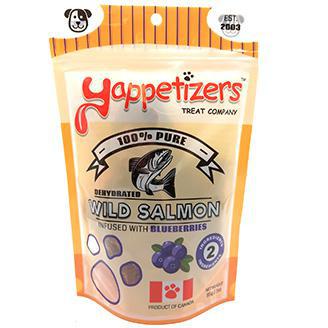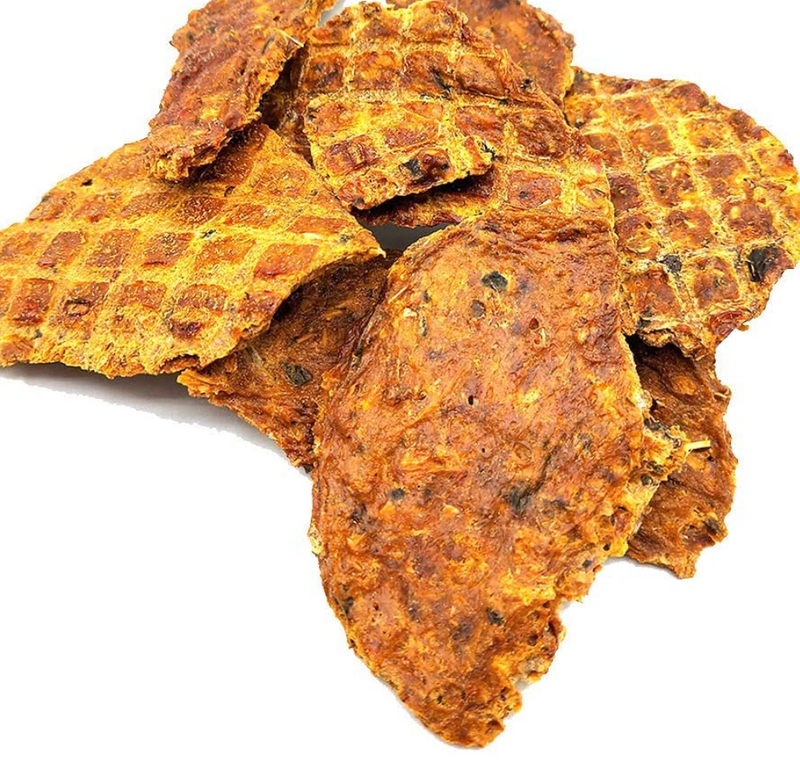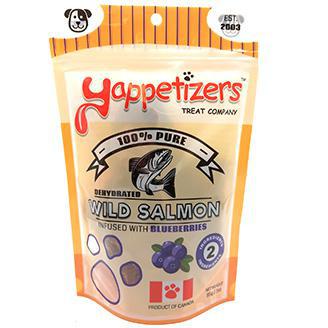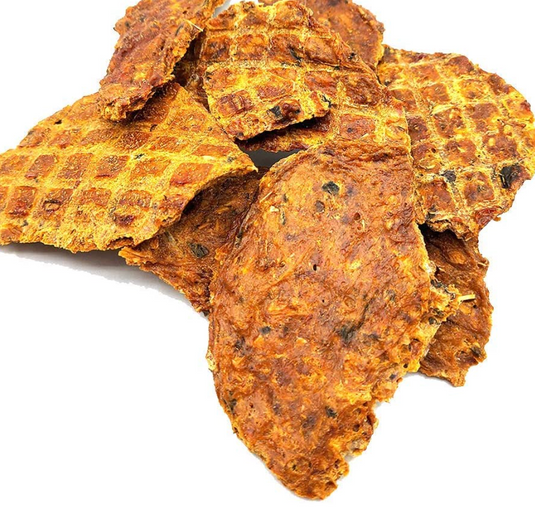

Ingredients: Salmon & Blueberries
Salmon is an excellent natural source of Omega-3 fatty acids, proteins, minerals and essential vitamins. Blueberries contain antioxidants, fiber and vitamins C and K. These nutrients support the immune system and contribute to overall health.
Salmon and blueberries treats for dogs are nutritious, as it is a good source of protein, omega-3 fatty acids, and other nutrients. However, it’s important to feed salmon to your dog in moderation, as it is high in fat and calories. v. If you are using salmon as a treat, you should adjust the amount of your dog’s regular meals accordingly to prevent overfeeding. Salmon and blueberries treats for dogs can be a healthy treat for dogs in moderation. They are a good source of antioxidants, which can help support the immune system, and they are low in calories. However, it’s important to remember that small amounts of blueberries should only be given to dogs, as large amounts can cause digestive upset.
There are several ways you can give your dog salmon as a treat:
- Cooked, plain salmon: You can give your dog small pieces of cooked, plain salmon as a treat. Just be sure to remove any bones, as they can be a choking hazard.
- Canned salmon: You can give your dog small amounts of canned salmon, but be aware that it may contain added salt and other ingredients that are not suitable for dogs.
- Salmon jerky: Several salmon jerky treats are available for dogs. Just be sure to read the ingredient list to ensure the treat does not contain any toxic ingredients for dogs, such as grapes or raisins.
As with any new food, it’s a good idea to slowly introduce salmon to your dog’s diet and observe any changes in behaviour or digestion. If your dog experiences any adverse reactions, stop feeding them salmon and consult with a veterinarian.
Here are a few tips for giving your dog blueberries:
- Fresh or frozen: You can treat your dog to fresh or frozen blueberries. Just be sure to wash them thoroughly to remove any dirt or pesticides.
- Dried: Dried blueberries are convenient but typically higher in sugar than fresh or frozen blueberries. They should be given to dogs in small amounts.
- Mixed into food: You can mix a few blueberries into your dog’s regular food as a tasty and nutritious addition.
As with any new food, it’s a good idea to introduce blueberries slowly to your dog’s diet and observe for any changes in behaviour or digestion. If your dog experiences adverse reactions, stop feeding them blueberries and consult a veterinarian.
How often should you feed your dog salmon?
It’s generally recommended to feed salmon to your dog in moderation, as it is high in fat and calories. Limiting treats to no more than 10% of your dog’s daily calorie intake is generally recommended. If you are using salmon as a treat, you should adjust the amount of your dog’s regular meals accordingly to prevent overfeeding.
It’s also a good idea to speak with a veterinarian or a pet nutritionist before making any changes to your dog’s diet. They can help you determine the appropriate serving size for your dog based on its age, size, and activity level.
As with any new food, it’s a good idea to slowly introduce salmon to your dog’s diet and observe any changes in behaviour or digestion. If your dog experiences any adverse reactions, stop feeding them salmon and consult with a veterinarian
Ingredients: Salmon & Blueberries
Salmon is an excellent natural source of Omega-3 fatty acids, proteins, minerals and essential vitamins. Blueberries contain antioxidants, fiber and vitamins C and K. These nutrients support the immune system and contribute to overall health.
Salmon and blueberries treats for dogs are nutritious, as it is a good source of protein, omega-3 fatty acids, and other nutrients. However, it’s important to feed salmon to your dog in moderation, as it is high in fat and calories. v. If you are using salmon as a treat, you should adjust the amount of your dog’s regular meals accordingly to prevent overfeeding. Salmon and blueberries treats for dogs can be a healthy treat for dogs in moderation. They are a good source of antioxidants, which can help support the immune system, and they are low in calories. However, it’s important to remember that small amounts of blueberries should only be given to dogs, as large amounts can cause digestive upset.
There are several ways you can give your dog salmon as a treat:
- Cooked, plain salmon: You can give your dog small pieces of cooked, plain salmon as a treat. Just be sure to remove any bones, as they can be a choking hazard.
- Canned salmon: You can give your dog small amounts of canned salmon, but be aware that it may contain added salt and other ingredients that are not suitable for dogs.
- Salmon jerky: Several salmon jerky treats are available for dogs. Just be sure to read the ingredient list to ensure the treat does not contain any toxic ingredients for dogs, such as grapes or raisins.
As with any new food, it’s a good idea to slowly introduce salmon to your dog’s diet and observe any changes in behaviour or digestion. If your dog experiences any adverse reactions, stop feeding them salmon and consult with a veterinarian.
Here are a few tips for giving your dog blueberries:
- Fresh or frozen: You can treat your dog to fresh or frozen blueberries. Just be sure to wash them thoroughly to remove any dirt or pesticides.
- Dried: Dried blueberries are convenient but typically higher in sugar than fresh or frozen blueberries. They should be given to dogs in small amounts.
- Mixed into food: You can mix a few blueberries into your dog’s regular food as a tasty and nutritious addition.
As with any new food, it’s a good idea to introduce blueberries slowly to your dog’s diet and observe for any changes in behaviour or digestion. If your dog experiences adverse reactions, stop feeding them blueberries and consult a veterinarian.
How often should you feed your dog salmon?
It’s generally recommended to feed salmon to your dog in moderation, as it is high in fat and calories. Limiting treats to no more than 10% of your dog’s daily calorie intake is generally recommended. If you are using salmon as a treat, you should adjust the amount of your dog’s regular meals accordingly to prevent overfeeding.
It’s also a good idea to speak with a veterinarian or a pet nutritionist before making any changes to your dog’s diet. They can help you determine the appropriate serving size for your dog based on its age, size, and activity level.
As with any new food, it’s a good idea to slowly introduce salmon to your dog’s diet and observe any changes in behaviour or digestion. If your dog experiences any adverse reactions, stop feeding them salmon and consult with a veterinarian


